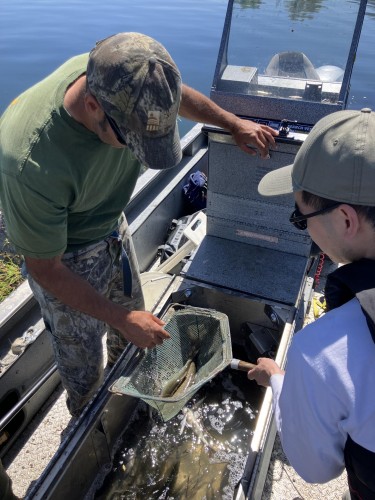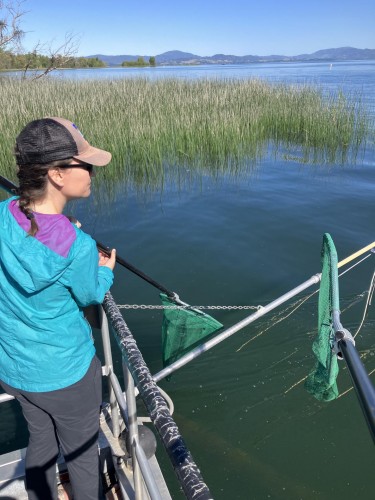Project Update: Net-Working with the Clear Lake Hitch
 What’s the best way to get to know
Clear Lake? A boat ride, of course!
What’s the best way to get to know
Clear Lake? A boat ride, of course!
Not just any boat ride. We recently joined California Department of Fish and Wildlife (CDFW) as staff conducted the last electrofishing survey of the season. These surveys are one of many community-wide efforts to monitor Clear Lake hitch populations, which is a culturally important species to Tribes and endemic to Clear Lake.
 This net-working opportunity was
twofold: meet key contacts working in the region and net as
many Clear Lake hitch as we could for counting. The survey
at Clear Lake State Park was one of 10
completed transects across the lake over 10 weeks this
year. We volunteered and helped CDFW capture, tally, and
release over 100 hitch in 3 hours!
This net-working opportunity was
twofold: meet key contacts working in the region and net as
many Clear Lake hitch as we could for counting. The survey
at Clear Lake State Park was one of 10
completed transects across the lake over 10 weeks this
year. We volunteered and helped CDFW capture, tally, and
release over 100 hitch in 3 hours!
 Because hitch use Clear Lake
tributaries to spawn, their populations have been impacted by
drought, in-stream barriers, water diversions,
pollution, and more. Tribal members call hitch Chi, and
have been working alongside partners for the fish to get federal
protections under the Endangered Species Act. These
electrofishing surveys have helped track hitch
populations since they became protected by the state as a
threatened species under the California Endangered Species Act in
2014.
Because hitch use Clear Lake
tributaries to spawn, their populations have been impacted by
drought, in-stream barriers, water diversions,
pollution, and more. Tribal members call hitch Chi, and
have been working alongside partners for the fish to get federal
protections under the Endangered Species Act. These
electrofishing surveys have helped track hitch
populations since they became protected by the state as a
threatened species under the California Endangered Species Act in
2014.
 Volunteering with CDFW allowed us to
meet the hitch, whose conservation is at the center of
conversations involving many different groups. We’ve learned
a lot about the impacts of non-native species like goldfish,
carp, and bass, and we were able to identify most of them in just
a few short hours. CDFW staff showed how to identify another
native fish, blackfish, that can easily be misidentified as
hitch. From conversations with community members,
one priority for youth is getting on the lake and knowing
about these species. For us to be able to include this as part of
the project, it’s important for us to build our own
connections through experiences like these.
Volunteering with CDFW allowed us to
meet the hitch, whose conservation is at the center of
conversations involving many different groups. We’ve learned
a lot about the impacts of non-native species like goldfish,
carp, and bass, and we were able to identify most of them in just
a few short hours. CDFW staff showed how to identify another
native fish, blackfish, that can easily be misidentified as
hitch. From conversations with community members,
one priority for youth is getting on the lake and knowing
about these species. For us to be able to include this as part of
the project, it’s important for us to build our own
connections through experiences like these.
 Since starting the
project in July 2022, we have been building a
better understanding of the Clear Lake region’s environmental
issues and connecting to ways for residents – including youth -
to get involved through community and citizen science.
Cultivating relationships helps strengthen collaboration between
the project team and local leaders rooted in the community.
Ultimately, experiences like these deepen understanding and
relationships that will help the youth community and citizen
science materials created for this project better serve the
region.
Since starting the
project in July 2022, we have been building a
better understanding of the Clear Lake region’s environmental
issues and connecting to ways for residents – including youth -
to get involved through community and citizen science.
Cultivating relationships helps strengthen collaboration between
the project team and local leaders rooted in the community.
Ultimately, experiences like these deepen understanding and
relationships that will help the youth community and citizen
science materials created for this project better serve the
region.
As we are about to enter year 2 of the Clear Lake project, we’re continuing to invite educators in the region to provide their feedback. If you’d like to be involved, find more information on the project page or reach out to Sarah Angulo, sangulo@ucdavis.edu.








